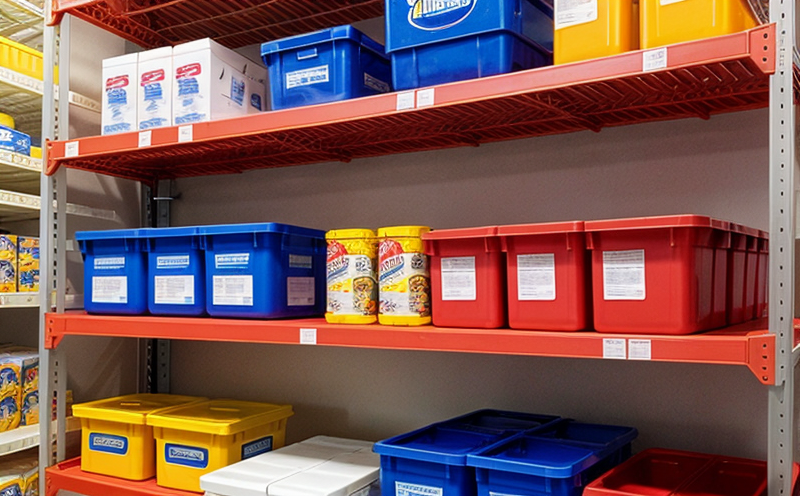ISO 20732 Packaging Integrity Impact on Shelf Life
The integrity of packaging materials plays a critical role in ensuring product quality and shelf life. The ISO 20732 standard provides guidelines for assessing the impact of packaging integrity on shelf life, which is essential for food and feed producers to maintain compliance with regulatory requirements while ensuring consumer safety and satisfaction.
Shelf life testing under this standard focuses on the ability of packaging materials to protect against contamination from external factors such as moisture, oxygen, light, and microorganisms. By understanding how different packaging types affect shelf stability, manufacturers can optimize their products' performance in storage conditions that mimic real-world environments.
The test protocol outlined by ISO 20732 involves subjecting packaged samples to controlled environmental stressors over time. This includes temperature cycling, humidity exposure, and light radiation. The goal is to simulate the expected degradation processes that occur during transportation and storage before the product reaches its final destination.
During testing, it's important to carefully prepare specimens according to the specified procedures outlined in ISO 20732. This typically involves selecting representative packages from each batch or lot of packaging material being evaluated. Specimens should be stored under controlled conditions prior to testing, ensuring they are free from any pre-existing damage that could affect results.
After preparing the specimens, the next step is to apply the appropriate test methods prescribed by ISO 20732. These may include vacuum sealing tests, gas permeability measurements, and microbial challenge studies depending on the type of packaging material used. Each method aims at assessing specific aspects related to the barrier properties offered by different materials.
The results from these tests provide valuable insights into how well various packaging options perform regarding preserving shelf life and maintaining product quality throughout distribution channels. Based on the findings, manufacturers can make informed decisions about selecting appropriate packaging solutions that meet both regulatory standards and business objectives.
In conclusion, adhering to ISO 20732 ensures that packaging integrity is maintained effectively, thereby protecting products against spoilage or contamination during their journey from factory floors to consumers' hands. This approach not only enhances overall product quality but also contributes significantly towards achieving sustainability goals within the industry.
Why Choose This Test
Selecting the right test for evaluating packaging integrity impacts on shelf life is crucial given today's stringent regulatory landscape and increasing consumer expectations. Here are several compelling reasons why ISO 20732 compliance should be prioritized:
- It aligns with global best practices and ensures harmonization across borders.
- The test results provide robust data supporting claims of product freshness and safety.
- Compliance reduces the risk of recalls and associated costs while enhancing brand reputation.
- It supports continuous improvement efforts by identifying weaknesses in current packaging systems early on.
By investing time and resources into implementing ISO 20732 shelf life tests, companies can build trust with customers who value transparency about product integrity throughout the supply chain. Additionally, this proactive approach demonstrates a commitment to sustainability through minimizing waste generation due to premature spoilage or contamination issues.
Quality and Reliability Assurance
The quality assurance process in ISO 20732 involves multiple stages designed to ensure that packaging materials meet the required standards for protecting products during storage and transport. At its core lies meticulous specimen preparation followed by rigorous testing under controlled conditions.
For successful specimen preparation, it is vital to follow precise instructions provided within the ISO document. This includes selecting appropriate sizes and shapes of containers suitable for the intended product type. Care must also be taken when handling these specimens to avoid introducing any contamination or physical damage that could skew test outcomes.
The testing phase itself requires adherence to strict protocols defined by ISO 20732, which cover various aspects such as initial conditioning procedures, exposure durations, and measurement techniques for evaluating barrier properties. Throughout this process, continuous monitoring ensures accurate recording of all relevant parameters affecting packaging performance.
Post-test analysis plays another crucial role in the quality assurance framework since it helps interpret results correctly and draw actionable insights from them. By comparing observed changes against expected values based on industry benchmarks or historical data, stakeholders can identify potential areas for improvement in future iterations of packaging designs.
Frequently Asked Questions
Use Cases and Application Examples
The applications for ISO 20732 extend beyond mere compliance; they serve as strategic tools in optimizing packaging solutions tailored specifically towards enhancing shelf life. Below are some practical scenarios where this test proves beneficial:
- Cereal Manufacturers: Ensuring that airtight seals prevent moisture ingress into grains, thus preserving freshness and flavor.
- Beverage Companies: Verifying whether flexible packaging withstands prolonged exposure to sunlight without compromising taste or color stability.
- Dairy Producers: Confirming the efficacy of modified atmosphere packaging in maintaining bacterial count within safe limits during extended refrigerated storage periods.
In each case, thorough understanding of how packaging interacts with stored goods enables better decision-making regarding material selection and design modifications aimed at extending shelf life efficiently.





